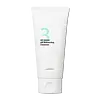What's inside
What's inside
 Key Ingredients
Key Ingredients

 Benefits
Benefits

 Concerns
Concerns

 Ingredients Side-by-side
Ingredients Side-by-side

Glycerin
HumectantWater
Skin ConditioningSodium Cocoyl Glycinate
CleansingDisodium Lauroyl Glutamate
CleansingBetaine
HumectantLauryl Betaine
Cleansing1,2-Hexanediol
Skin ConditioningHydroxypropyl Starch Phosphate
Laminaria Japonica Extract
Skin ProtectingEclipta Prostrata Leaf Extract
Skin ConditioningCentella Asiatica Extract
CleansingFicus Carica Fruit Extract
HumectantUlmus Davidiana Root Extract
Skin ConditioningAmaranthus Caudatus Seed Extract
Skin ConditioningRosmarinus Officinalis Leaf Oil
MaskingHydrogenated Lecithin
EmulsifyingSodium Chloride
MaskingPolyquaternium-39
Decylene Glycol
Skin ConditioningButylene Glycol
HumectantFructooligosaccharides
HumectantBeta-Glucan
Skin ConditioningHydrolyzed Hyaluronic Acid
HumectantCeramide NP
Skin ConditioningHydroxyacetophenone
AntioxidantEthylhexylglycerin
Skin ConditioningGlycerin, Water, Sodium Cocoyl Glycinate, Disodium Lauroyl Glutamate, Betaine, Lauryl Betaine, 1,2-Hexanediol, Hydroxypropyl Starch Phosphate, Laminaria Japonica Extract, Eclipta Prostrata Leaf Extract, Centella Asiatica Extract, Ficus Carica Fruit Extract, Ulmus Davidiana Root Extract, Amaranthus Caudatus Seed Extract, Rosmarinus Officinalis Leaf Oil, Hydrogenated Lecithin, Sodium Chloride, Polyquaternium-39, Decylene Glycol, Butylene Glycol, Fructooligosaccharides, Beta-Glucan, Hydrolyzed Hyaluronic Acid, Ceramide NP, Hydroxyacetophenone, Ethylhexylglycerin
Water
Skin ConditioningGlycerin
HumectantPropanediol
SolventCoco-Glucoside
CleansingXanthan Gum
EmulsifyingSodium Cocoamphoacetate
CleansingCitric Acid
BufferingSodium Chloride
MaskingDisodium EDTA
Ethylhexylglycerin
Skin ConditioningCnidium Officinale Root Water
MaskingAngelica Acutiloba Root Water
Skin ConditioningButylene Glycol
HumectantDioscorea Japonica Root Extract
Skin ConditioningRubus Idaeus Fruit Extract
AstringentUlmus Davidiana Root Extract
Skin ConditioningSalicornia Herbacea Extract
Skin ConditioningMorus Alba Leaf Extract
Skin ConditioningAngelica Keiskei Extract
Antioxidant1,2-Hexanediol
Skin ConditioningTocopherol
AntioxidantWater, Glycerin, Propanediol, Coco-Glucoside, Xanthan Gum, Sodium Cocoamphoacetate, Citric Acid, Sodium Chloride, Disodium EDTA, Ethylhexylglycerin, Cnidium Officinale Root Water, Angelica Acutiloba Root Water, Butylene Glycol, Dioscorea Japonica Root Extract, Rubus Idaeus Fruit Extract, Ulmus Davidiana Root Extract, Salicornia Herbacea Extract, Morus Alba Leaf Extract, Angelica Keiskei Extract, 1,2-Hexanediol, Tocopherol
Ingredients Explained
These ingredients are found in both products.
Ingredients higher up in an ingredient list are typically present in a larger amount.
1,2-Hexanediol is a synthetic liquid and another multi-functional powerhouse.
It is a:
- Humectant, drawing moisture into the skin
- Emollient, helping to soften skin
- Solvent, dispersing and stabilizing formulas
- Preservative booster, enhancing the antimicrobial activity of other preservatives
Butylene Glycol (or BG) is used within cosmetic products for a few different reasons:
Overall, Butylene Glycol is a safe and well-rounded ingredient that works well with other ingredients.
Though this ingredient works well with most skin types, some people with sensitive skin may experience a reaction such as allergic rashes, closed comedones, or itchiness.
Learn more about Butylene GlycolEthylhexylglycerin (we can't pronounce this either) is commonly used as a preservative and skin softener. It is derived from glyceryl.
You might see Ethylhexylglycerin often paired with other preservatives such as phenoxyethanol. Ethylhexylglycerin has been found to increase the effectiveness of these other preservatives.
Glycerin is already naturally found in your skin. It helps moisturize and protect your skin.
A study from 2016 found glycerin to be more effective as a humectant than AHAs and hyaluronic acid.
As a humectant, it helps the skin stay hydrated by pulling moisture to your skin. The low molecular weight of glycerin allows it to pull moisture into the deeper layers of your skin.
Hydrated skin improves your skin barrier; Your skin barrier helps protect against irritants and bacteria.
Glycerin has also been found to have antimicrobial and antiviral properties. Due to these properties, glycerin is often used in wound and burn treatments.
In cosmetics, glycerin is usually derived from plants such as soybean or palm. However, it can also be sourced from animals, such as tallow or animal fat.
This ingredient is organic, colorless, odorless, and non-toxic.
Glycerin is the name for this ingredient in American English. British English uses Glycerol/Glycerine.
Learn more about GlycerinChances are, you eat sodium chloride every day. Sodium Chloride is also known as table salt.
This ingredient has many purposes in skincare: thickener, emulsifier, and exfoliator.
You'll most likely find this ingredient in cleansers where it is used to create a gel-like texture. As an emulsifier, it also prevents ingredients from separating.
There is much debate on whether this ingredient is comedogenic. The short answer - comedogenic ratings don't tell the whole story. Learn more about comegodenic ratings here.
The concensus about this ingredient causing acne seems to be divided. Research is needed to understand if this ingredient does cause acne.
Scrubs may use salt as the primary exfoliating ingredient.
Learn more about Sodium ChlorideThis tree is also known as the David Elm. It contains the ingredient bakuchiol.
Other great compounds found in this ingredient include galactose, glucose, and phenolics. The sugar content gives it great skin hydrating properties. Phenolics are potent antioxidants commonly found in fruits and veggies.
A 2020 study found the phenolics of this root to have an anti-inflammatory effect.
Fun fact: This ingredient is used in traditional Asian medicine.
Learn more about Ulmus Davidiana Root ExtractWater. It's the most common cosmetic ingredient of all. You'll usually see it at the top of ingredient lists, meaning that it makes up the largest part of the product.
So why is it so popular? Water most often acts as a solvent - this means that it helps dissolve other ingredients into the formulation.
You'll also recognize water as that liquid we all need to stay alive. If you see this, drink a glass of water. Stay hydrated!
Learn more about Water